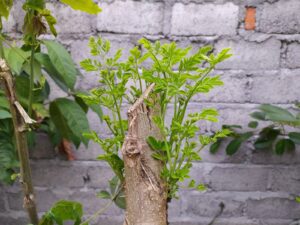Why Moringa Leaves Curl
Moringa, also known as the “Miracle Tree,” is an incredibly nutrient-dense plant that has been used for centuries in traditional medicine. Its leaves are particularly valuable due to their high levels of vitamins and minerals, making them an essential component of many health and wellness products. However, despite its many benefits, Moringa plants can sometimes face issues that affect their leaves, such as curling. Understanding why Moringa leaves curl is essential for the plant’s survival and for reaping its many benefits. In this article, we will explore the various causes of Moringa leaves curling, the preventive measures that can be taken, and the treatment options available. By the end of this article, you will have a comprehensive understanding of how to keep your Moringa plants healthy and thriving, ensuring a steady supply of this valuable resource.

Causes of Moringa Leaves Curling
Moringa plants are generally hardy and can withstand a variety of environmental conditions. However, several factors can cause the leaves to curl, including changes in temperature, watering issues, and light exposure. Additionally, pests and diseases can also cause Moringa leaves to curl. Caterpillars, whiteflies, powdery mildew, and leaf spot are common culprits that can damage the leaves and affect the plant’s overall health. Understanding these causes is crucial for identifying the problem and taking the necessary corrective measures. In the following sections, we will delve deeper into the causes of Moringa leaves curling, including environmental factors and pests/diseases, and explore the best ways to prevent and treat them.
Prevention of Moringa Leaves Curling
Prevention is always better than cure, and this is especially true for Moringa plants. By taking proactive measures to prevent leaves from curling, you can avoid potential problems and ensure that your Moringa plants grow healthy and strong. To prevent Moringa leaves from curling due to environmental factors, you need to maintain consistent watering. Also, provide adequate light exposure, and control the temperature. For pests and diseases, regular inspection of the leaves, early identification of problems, and the use of organic pesticides are essential. By implementing these measures, you can prevent leaves from curling and promote optimal growth and productivity. In the next section, we will discuss treatment options available in case Moringa leaves begin to curl.

Treatment of Moringa Leaf Curling
When Moringa leaves start to curl, it’s important to take immediate corrective measures to prevent the problem from worsening. Treatment options vary depending on the cause of the curling. For leaves that have curled due to environmental factors, pruning of affected leaves, soil conditioning, and nutrient supplementation can help. In case of pests and diseases, use of organic pesticides, removal of affected leaves, and isolation of infected plants are recommended. It’s important to take action as soon as possible to prevent further damage to the plant and ensure a healthy crop. Regular monitoring of the plant’s health and taking timely action can help prevent leaves from curling and promote optimal growth and productivity.

In Summary
Moringa is a highly beneficial plant that has been used for centuries due to its incredible nutritional value. However, Moringa plants can experience leaf curling due to various factors such as environmental conditions, pests, and diseases. It is essential to identify the cause of leaf curling to take the necessary preventive and corrective measures. Preventive measures such as consistent watering, proper light exposure, and timely identification of pests and diseases can help keep your Moringa plants healthy and productive. In case of leaf curling, treatment options such as pruning of affected leaves. Soil conditioning, nutrient supplementation, use of organic pesticides, and removal of affected leaves can help restore the plant’s health. By taking proactive measures, you can prevent leaf curling and ensure a steady supply of this valuable resource.
In conclusion, Moringa leaves are essential for health and wellness, and understanding how to prevent and treat leaf curling is crucial for maintaining their benefits.
References
- “Moringa oleifera: A Food Plant with Multiple Medicinal Uses.” Phytotherapy Research. https://pubmed.ncbi.nlm.nih.gov/17089328/
Moringa With Barry stores offer a variety of moringa products. These include: Moringa Powder, Moringa Tea, Moringa Capsules and Moringa Oil.
Read more:
1. The Benefits of Moringa: Why It’s Good for You
2. 11 Compelling Reasons: Using Moringa in Daily Routine
3. Understanding Moringa Leaves: Why They Turn Yellow
4. Empowering Women’s Health: The Advantages of Moringa
5. Unveiling the Benefits: How Moringa Supports Men’s Health




